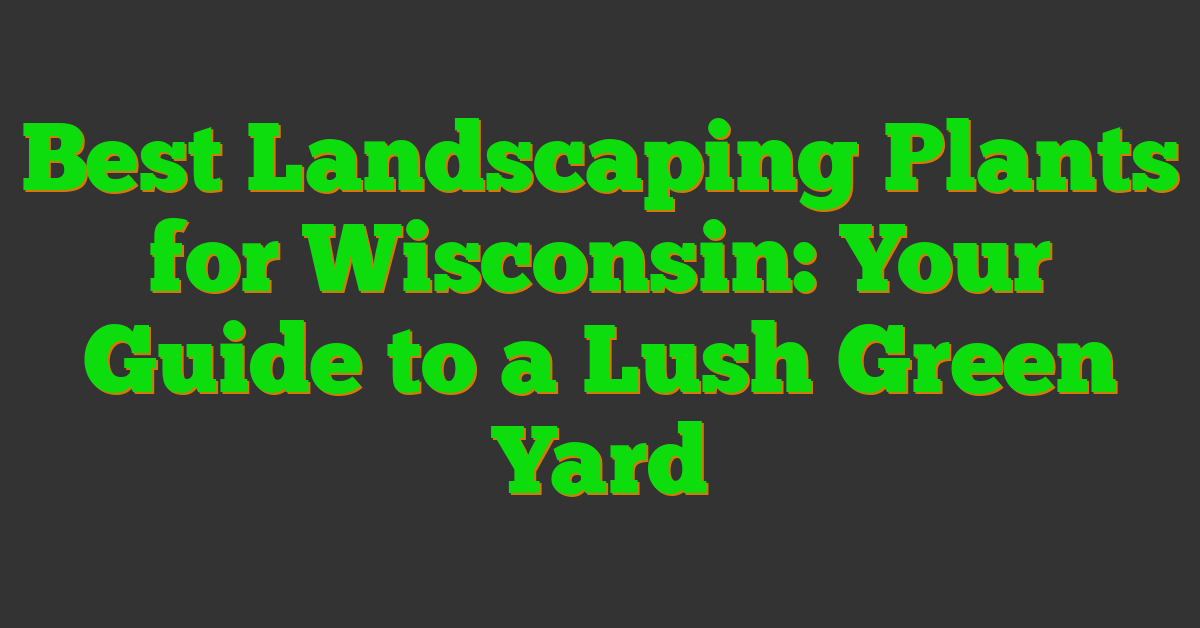Living in Indiana, you’re graced with a climate that’s just begging for some beautiful landscaping plants. But with so many options available, knowing which ones to choose can feel like a daunting task. Fear not! I’m here to help guide your green thumb and assist in making your garden the talk of the neighborhood.

Indiana’s climate, ranging from humid summers to frosty winters, is perfect for a variety of flora. You’ve got plenty of options when it comes to picking out perennials and annuals that will thrive in your yard. And don’t forget about shrubs and trees – they can provide not only aesthetic value but also much-needed shade during those hot Hoosier summers.
So whether you’re a seasoned gardener or just starting on this journey, take comfort in knowing that finding the perfect plants doesn’t have to be as tough as pulling weeds. Stick around and we’ll dig into what makes these top picks the best landscaping plants for Indiana.
Understanding Indiana’s Climate and Soil
So, you’re thinking about sprucing up your outdoor space with some local greenery. That’s fantastic! But before you start digging into the ground, it’s crucial to understand Indiana’s unique climate and soil conditions.
Indiana has a humid continental climate, which means it experiences four distinct seasons. Summers in Indiana can get pretty hot, typically reaching 85°F during the day while winters are quite chilly with temperatures often dipping below freezing. You might be wondering what this means for your landscaping plans? Well, these temperature extremes can affect plant growth and survival, so choosing native or hardy plants is key.
Moving on to the soil part of things – Indiana boasts a variety of soil types due to its diverse geography. The northern region predominately features clay-rich soils that retain water well but drain slowly. In contrast, the southern parts have sandy soils that provide excellent drainage but may require additional watering.
Here’s a little tip from yours truly: Before planting anything, it’d be wise to test your garden soil first. It’ll give you an idea of its nutrient content and pH level—two critical factors in determining what plants will thrive best in your yard.
Now don’t worry if all this sounds overwhelming because we’ve got you covered! We’ll guide you through choosing the best landscaping plants fit for Indiana’s specific conditions in later sections of this article! So sit tight as we embark on a journey towards creating your dream Hoosier garden.
Choosing the Right Plants for Your Landscape
Ready to spruce up your Indiana landscape? First things first, you’ve got to choose the right plants. This isn’t as simple as picking out what looks good at the garden center. You’ll need to consider factors like sunlight, soil type, and how much care each plant requires.
Indiana’s climate can be a bit of a challenge for some plants. The state experiences hot summers and cold winters with significant temperature fluctuations in between. So it’s crucial that you select plants that are hardy enough to handle these conditions.
Let’s take a look at some top contenders:
- Dogwood Trees: These beauties thrive in Indiana’s climate. They’re also pretty versatile when it comes to sun exposure, doing well in partial shade or full sun.
- Hostas: If your yard is on the shady side, hostas might be just what you need. They’re known for their large leaves which come in various shades of green.
- Black-eyed Susans: Want something that’ll add a pop of color? Black-eyed Susans are perennial wildflowers that bloom from midsummer well into fall.
Now let’s talk about shrubs – they’re great if you’re looking for something low maintenance yet visually appealing.
- Boxwoods are an excellent choice because they maintain their green color year-round and can withstand Indiana’s winter temperatures.
- On the other hand, if you prefer flowering shrubs, consider adding some Hydrangeas to your landscape. They produce gorgeous blooms during summer and thrive best in partial shade.
Remember not all plants will grow equally well throughout Indiana due its varied terrain such as sandy soils near Lake Michigan or clay soils more common further south. It’s always beneficial to get your soil tested before making final decisions on plant selection!
Choosing the right plants may seem daunting but trust me – once you start seeing those beautiful blooms and lush greenery, you’ll know it was all worth it! So get out there and start planning your dream Indiana landscape.
Top 5 Native Indiana Plants for Landscaping
When you’re thinking about sprucing up your garden, consider using native plants. These are plants that naturally grow in the area, so they’ll thrive in your backyard with less fuss. Here’s a list of five top-performing native plants you should consider when planning your landscape in Indiana.
- Black-Eyed Susan – It’s hard to miss these stunning yellow flowers with their striking black centers. Black-eyed Susans love the sun and can handle drought conditions, making them a great choice if you’re after low-maintenance beauty.
- Purple Coneflower – With its vibrant purple blooms and sturdy stems, the Purple Coneflower is another great pick for an Indiana garden. It’s also known as Echinacea and it attracts butterflies!
- Indiana Banana or Pawpaw – This one’s not just pretty; it provides delicious fruits too! The Pawpaw tree produces large leaves which provide excellent shade during hot summers.
- Redbud Tree – If you’ve got space for a small tree, why not plant an Indiana Redbud? They bloom early spring with pink blossoms that will surely take everyone’s breath away.
- Switchgrass – For something different, try planting switchgrass around your yard. This tough grass stands tall throughout the year and changes color seasonally giving a dynamic feel to your landscape.
Remember: One size doesn’t fit all when it comes to landscaping plants! Make sure to do some research on what would work best for your specific outdoor space before making decisions on what to plant.
Easiest Perennials to Grow in Indiana
Let’s face it, you’re probably not looking for a high-maintenance garden. If your goal is to add some life and color to your landscape without the extra work, perennials are just what you need. They’re nature’s gift that keeps on giving year after year.
Now if you’re wondering about which perennials do best in Indiana, we’ve got you covered. First up is the Black-Eyed Susan. Native to North America, this sunny yellow flower thrives from midsummer through fall and doesn’t mind the Hoosier state’s hot summers.
Next on our list is the Daylily. It’s hard not to love these beauties. They come in an array of colors and can withstand most soil conditions – talk about low maintenance! And let’s not forget Coneflowers, with their vibrant purple petals they’ll definitely make your neighbors stop and stare.
« Best Landscaping Plants for North Dakota: Your Ultimate Green Thumb Guide Best Landscaping Plants for Florida: Your Guide to a Lush Sunshine State Garden »
For those who prefer something a bit more subtle but equally gorgeous, Hostas are worth considering. With lush green leaves that range from light lime to deep emerald shades, they add a touch of sophistication and tranquility to any garden setting.
Last but certainly not least are Peonies – Indiana’s state flower! Known for their sweet scent and large blossoms that come in white, pink or red hues, they have a well-deserved place in any Hoosier garden.
So there you have it folks — five easy-to-grow perennial plants perfect for sprucing up your Indiana landscape:
- Black-Eyed Susan
- Daylily
- Coneflower
- Hosta
- Peony
Remember: gardening isn’t just about making your space look good; it’s also about creating an environment where nature can thrive too!
Drought-Tolerant Landscaping Plants for Indiana
When you’re landscaping in Indiana, it’s crucial to choose plants that can withstand the state’s hot, dry summers. Let me guide you through some drought-tolerant options that’ll keep your garden gorgeous even when rain is scarce.
First up, consider incorporating Black-Eyed Susans into your landscape. These hearty flowers continue to bloom beautifully under the scorching sun. Their vibrant yellow petals bring a splash of color and their resilience makes them ideal for an Indiana summer.
You’d also be wise to include Ornamental Grasses in your plans. Varieties like Prairie Dropseed and Little Bluestem are native to Indiana and thrive in its conditions. They provide height, texture, and movement – a perfect addition if you’re aiming for dynamic visual interest in your garden.
Let’s not forget about Coneflowers. Not only do they come in a range of colors from white to pink to purple, but they’re also very tolerant of dry periods. What’s more? They attract butterflies! Imagine having these fluttering visitors adding life to your yard on sunny days!
Here are few more suggestions:
- Yucca: This plant sports waxy leaves which help it retain water during droughts.
- Sedum: An attractive succulent that comes in numerous varieties.
- Russian Sage: Its beautiful blue flowers add freshness while being able to endure high heat levels.
Remember folks, choosing the right plants doesn’t just make gardening easier – it also helps conserve water resources during drier months. So why not give these tough yet stunning plants a spot on your next landscaping project?
Best Shade-Loving Plants for Indiana Gardens
Stepping into the realm of shade-loving plants, you’ll find a plethora of lush flora that thrives in the cooler corners of your Indiana garden. These beauties aren’t just survivors; they’re performers that add depth and texture to those areas where sunlight plays hard-to-get.
First off, let’s talk about Hostas. They’re like the rock stars of the shady garden world! With over 70 species available, you can play around with their wide variety of sizes and leaf colors to create your unique aesthetic. Their resilience is another plus – they’ve got a reputation for being low maintenance yet high impact.
Next up are Bleeding Hearts (Dicentra). If you’re after a touch of romantic drama, these heart-shaped bloomers are perfect for your shaded spaces. Besides being ethereal beauties, they’re also perennials – meaning they’ll be back year after year to grace your gardens with their charm.
Then there’s the ever-reliable Ferns. These ancient plants provide an elegant backdrop to many a garden scene with their feathery fronds and rich green hues. In particular, Lady Ferns and Christmas Ferns are known to do particularly well in Indiana’s climate.
Astilbes too deserve a shout out here! Their feathery plumes come in various shades from white through pink and red – adding some serious pizzazz to your shaded spots. And guess what? They don’t mind wet feet either!
And finally, consider adding some Solomon’s Seal (Polygonatum). Growing up to 3 feet tall with pendulous bell-like flowers hanging underneath arching stems – these native beauties will bring both height and movement into your garden design.
Let’s recap:
- Hostas: Low-maintenance plants offering variety in size & color.
- Bleeding Hearts (Dicentra): Heart-shaped blooms bringing romance to your garden.
- Ferns: Ancient plants providing elegant backdrops with their feathery fronds.
- Astilbes: Adding pizzazz with their feathery plumes in various shades.
- Solomon’s Seal (Polygonatum): Native species adding height and movement.
Shade doesn’t mean you have to compromise on beauty or variety in your Indiana garden. With these shade-loving stars, you’re all set to create a lush oasis that’s as unique as you are!
Maintenance Tips for Healthy Landscaping in Indiana
Let’s dive into some maintenance tips to keep your landscaping vibrant and fresh all year round! Remember, maintaining a healthy landscape isn’t just about aesthetics. It’s also about fostering an environment where your plants can thrive.
Firstly, you’ve got to know your soil. It plays a key role in how well your plants will grow. Most Indiana soils are loamy, which means they have a balanced mix of sand, silt, and clay particles. This type of soil is usually great for growing most kinds of plants but it never hurts to get a soil test done anyway. You’ll want to ensure that the pH level is just right – not too acidic or alkaline.
Next up: watering wisely! Overwatering is often more harmful than under-watering. Deep watering encourages roots to grow deeper and stronger which helps them withstand drought better. And remember: early morning is the best time to water as it reduces evaporation loss.
Let’s talk mulching now. A good layer of organic mulch can help retain moisture, suppress weeds and gradually improve the structure and fertility of your soil as it breaks down over time. Aim for 2-3 inches thick across your garden beds.
Don’t forget pruning either – it’s crucial for promoting growth and keeping pests at bay. Prune deciduous trees when they’re dormant – late winter or early spring is ideal.
Lastly, keep those pesky pests in check! Look out for signs like discolored leaves or stunted growth so you can nip any infestations in the bud before they wreak havoc on your beautiful landscape!
Here are some quick do’s & don’ts:
- DO perform regular check-ups on plant health
- DON’T ignore signs of pests
- DO prune regularly
- DON’T overwater
By following these simple tips you’ll be on your way to having a lush, thriving landscape that is the envy of your neighborhood!
Conclusion: Creating an Ideal Landscape in Indiana
So, you’re now armed with the knowledge of some of the best landscaping plants for Indiana. But remember, it’s not just about choosing the right plants. It’s about understanding your environment and working with what it gives you.
Think of your garden as a canvas and these native Indiana plants as your palette. You’ve got shade-loving ferns for those darker corners and colorful coneflowers to add a splash of brightness. Use prairie grasses to add texture and height to your landscape design.
You may also want to consider factors beyond aesthetics when selecting plants. Some are excellent for attracting pollinators like bees and butterflies which can help keep your entire garden healthy and thriving.
It’s also important to note that while these are some ideal choices, they aren’t the only ones! There are plenty of other great options out there:
- For trees, consider planting Oaks or Maples
- For shrubs, try Spirea or Boxwoods
- If you’re looking for a good groundcover plant, why not go for Creeping Phlox?
You see, creating an ideal landscape in Indiana is all about being smart with your choices and mixing things up a bit!
Remember how we talked about the importance of considering different seasons? Keep that in mind too – choose a mix of spring bloomers like Jacob’s Ladder alongside autumn standouts like Aster to ensure year-round beauty.
Finally, don’t forget that gardening should be fun! Don’t stress yourself out trying to make everything perfect right away. Instead, enjoy the process – watch as those tiny seedlings grow into beautiful mature plants over time.
Creating an ideal landscape in Indiana requires patience but trust us – seeing your garden flourish will be worth every ounce of effort you put into it!










